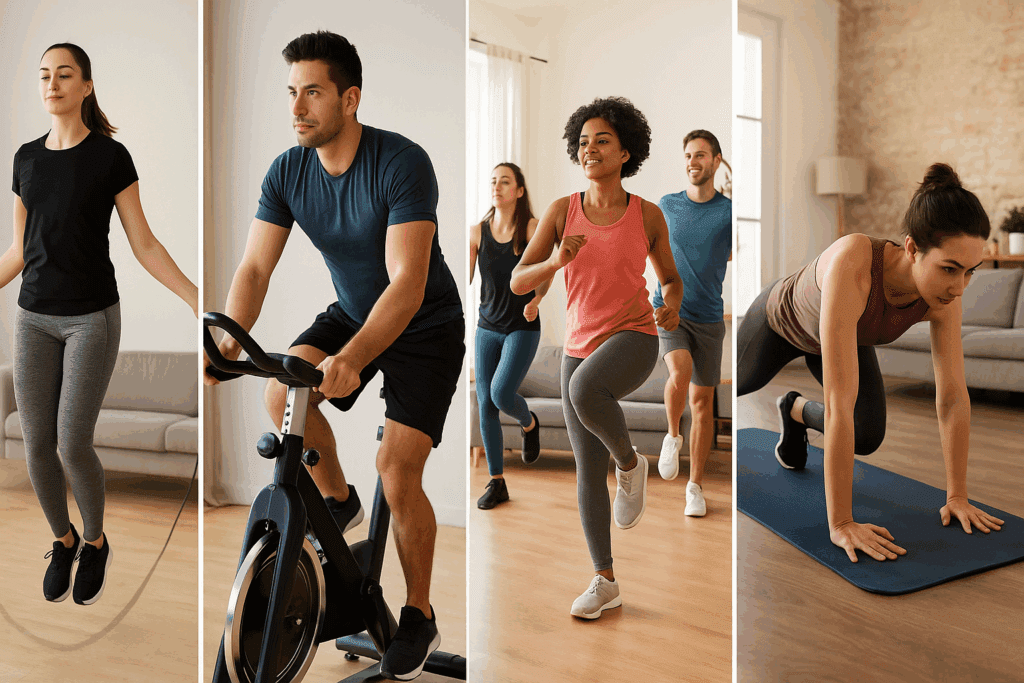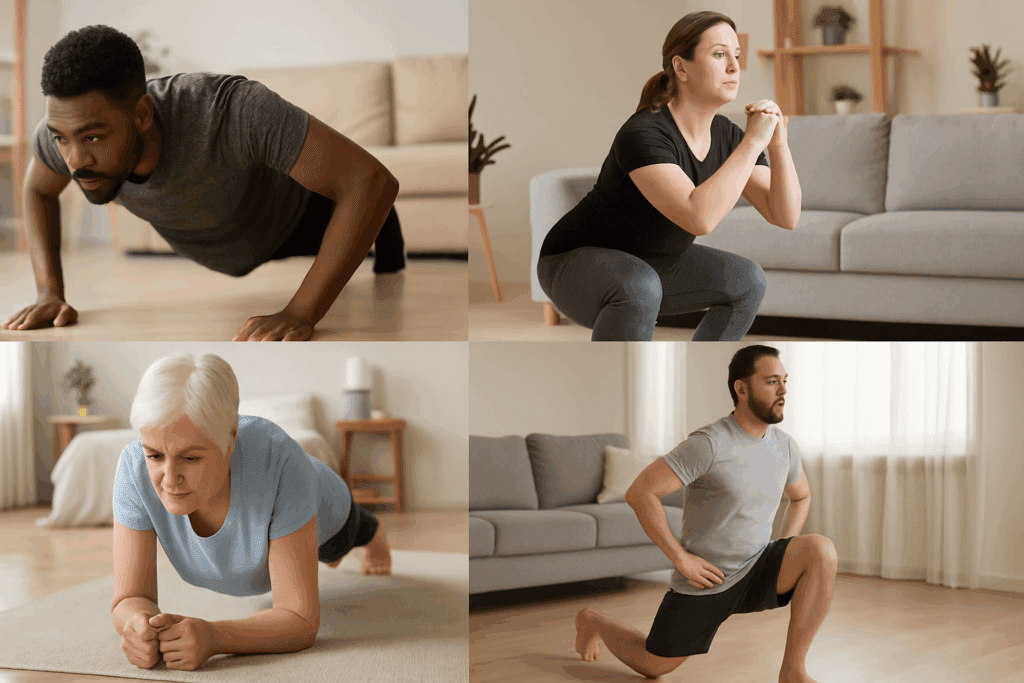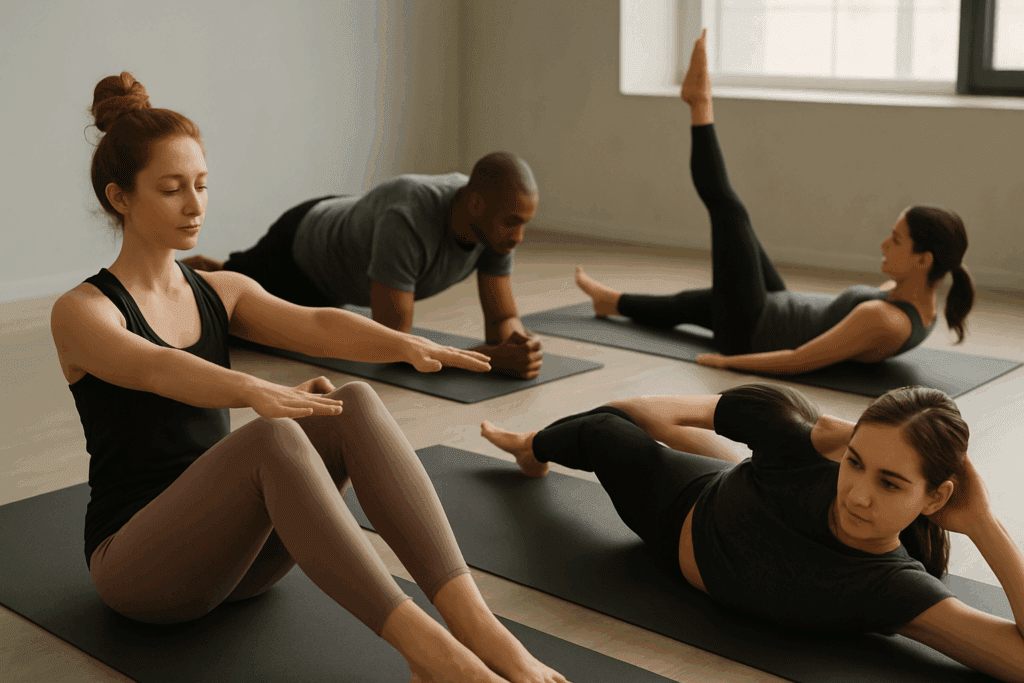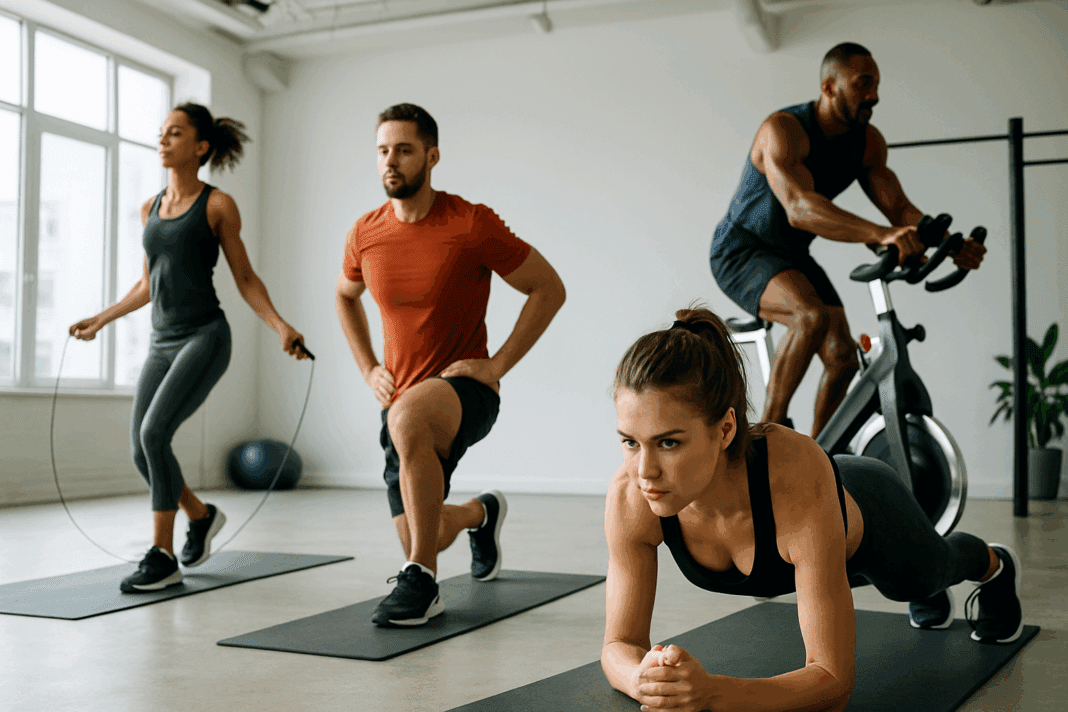Unlocking the Potential of Indoor Workouts for Endurance and Stamina
In a world that increasingly demands flexibility and efficiency, the value of indoor exercises has never been more apparent. With weather unpredictability, busy schedules, and limited access to gyms, many people are turning to the best indoor workout routines to meet their fitness goals. More than a matter of convenience, training indoors offers a controlled environment where distractions are minimized, allowing for consistency and focus. When approached strategically, workouts for indoors can be just as—if not more—effective than traditional outdoor training, particularly when the goal is to enhance endurance and stamina.
You may also like: How to Increase Stamina and Endurance Naturally: Smart Training Tips and Nutrition Habits That Support Cardiovascular Fitness
For athletes and fitness enthusiasts alike, endurance and stamina are foundational to peak performance. These attributes influence everything from cardiovascular health to muscular efficiency and mental resilience. The misconception that only outdoor running or gym machines can foster these qualities overlooks the tremendous versatility of indoor training. Whether it’s high-intensity interval training (HIIT), bodyweight circuits, or structured cardio sessions, indoor exercises can be tailored to steadily build both aerobic and anaerobic capacity. And for those seeking the best indoor workout strategies, evidence-based techniques rooted in exercise physiology offer powerful tools for maximizing results.

The Science of Endurance and Stamina Development
To fully appreciate how indoor workouts can enhance endurance and stamina, it’s crucial to first understand what these terms truly mean. Endurance generally refers to the body’s ability to sustain prolonged physical activity, predominantly fueled by aerobic metabolism. It is heavily reliant on cardiovascular efficiency and the body’s ability to use oxygen to produce energy. Stamina, while related, often encompasses both physical and mental resilience—the capacity to maintain high performance over time, even when fatigued.
Physiologically, developing endurance requires adaptations such as increased mitochondrial density in muscles, improved capillary networks, and enhanced cardiac output. Stamina also benefits from neuromuscular adaptations and improved lactate threshold, which allows the body to operate at higher intensities without succumbing to exhaustion. Indoor exercises that incorporate intervals, steady-state cardio, and functional strength training stimulate these adaptations effectively.
One of the advantages of workouts for indoors is the ability to structure them precisely around these physiological goals. Whether using a stationary bike, rowing machine, or simply a resistance mat, indoor training provides a platform for structured progression, allowing individuals to gradually build tolerance to higher workloads. Importantly, it’s not just the physical adaptations that count—mental toughness is equally critical, and indoor routines can challenge the mind as much as the body.

Best Indoor Cardio Exercises to Build Endurance
Among the most effective methods for increasing endurance through indoor workouts is cardiovascular training. This includes a wide range of activities that elevate the heart rate and maintain it at target zones over time. Jump rope, for instance, remains a deceptively powerful tool for cardiovascular fitness. When performed in intervals or as part of a circuit, it enhances aerobic capacity while engaging multiple muscle groups.
Similarly, dancing-based workouts like Zumba or cardio kickboxing combine rhythm and movement with sustained exertion, providing an engaging alternative to traditional jogging or cycling. Stationary bikes and treadmills, when available, are also cornerstones of endurance training indoors. By manipulating resistance, incline, and duration, users can simulate outdoor terrain and create progressive challenges.
Even without equipment, indoor exercises such as high knees, mountain climbers, and jumping jacks can be pieced together into a cohesive routine. These movements not only raise the heart rate but also enhance muscular endurance, coordination, and agility. The best indoor workout plans balance variation and progression, ensuring continual improvement without monotony. Moreover, consistency is key—performing cardio routines at least three to five times a week fosters sustained cardiovascular improvement.

Bodyweight Training to Strengthen Stamina and Muscular Endurance
While cardio forms the backbone of endurance development, bodyweight strength training is indispensable for enhancing muscular stamina. The principle here lies in performing exercises that engage multiple muscle groups repetitively without external resistance. Push-ups, planks, squats, and lunges are exemplary indoor exercises that activate large muscle chains and promote functional strength.
These exercises can be modified in endless ways to increase intensity or focus on specific muscle groups. For example, incorporating tempo changes—such as slow descents in push-ups—recruits muscle fibers more thoroughly and builds endurance under tension. Circuit training, which strings together several bodyweight movements with minimal rest, keeps the heart rate elevated while targeting both muscular and aerobic systems simultaneously.
Crucially, stamina is not just about strength, but about the ability to exert force over time without fatigue. This makes bodyweight exercises ideal, as they can be performed for higher reps and longer durations. Indoor workouts structured around bodyweight training are also easily scalable, making them suitable for beginners and advanced athletes alike. As stamina improves, additional elements such as balance, core activation, and movement control become increasingly prominent.

High-Intensity Interval Training (HIIT): A Catalyst for Endurance Gains
For those seeking rapid and measurable gains in endurance and stamina, high-intensity interval training (HIIT) is among the best indoor workout methods available. HIIT involves alternating short bursts of maximum effort with periods of active recovery. This method challenges both the aerobic and anaerobic energy systems, pushing the body to adapt more quickly than steady-state training alone.
Indoor HIIT sessions can be customized using simple movements such as burpees, squat jumps, and sprint intervals. The key is to maintain intensity during work intervals and allow sufficient, but not excessive, recovery. Scientific research supports HIIT’s effectiveness in improving VO2 max, lactate threshold, and overall endurance capacity. Additionally, the efficiency of HIIT is a major advantage for those with limited time—workouts as short as 20 minutes can yield significant benefits when performed consistently.
Mentally, HIIT also cultivates resilience. The challenge of pushing through discomfort during high-intensity intervals mimics the psychological demands of endurance sports, making it a dual-pronged tool for performance enhancement. Despite its intensity, HIIT is surprisingly accessible, requiring minimal space and equipment—perfect for anyone committed to workouts for indoors that don’t compromise on results.

Core Conditioning for Stability and Sustained Power
Core strength plays a pivotal role in supporting endurance and stamina, yet it is often underestimated. A strong core facilitates efficient movement, reduces fatigue, and lowers the risk of injury during prolonged activity. Indoor exercises that target the abdominal, pelvic, and lower back muscles form an essential component of any comprehensive workout plan.
Traditional movements like planks, bicycle crunches, and leg raises build static and dynamic core strength. Pilates routines, which emphasize controlled motion and breathwork, are particularly well-suited to indoor environments. They enhance body awareness, improve posture, and foster muscular coordination—all of which contribute to sustainable performance.
What distinguishes the best indoor workout approaches is the integration of core training not as an afterthought, but as a foundation. Endurance athletes, from runners to cyclists, benefit from core conditioning by improving kinetic chain efficiency. When the trunk is stable, limbs can move more freely and with greater control, conserving energy over time. Even for non-athletes, strong core muscles translate into better everyday movement and less susceptibility to fatigue.
Optimizing Recovery to Maximize Training Gains
Building endurance and stamina is not solely a matter of physical effort—it also depends on effective recovery. Indoor training can be intense and demanding, especially with consistent HIIT, cardio, and strength sessions. Therefore, incorporating structured recovery strategies ensures that the body adapts, repairs, and grows stronger between workouts.
Active recovery techniques such as yoga, stretching, and foam rolling are perfectly suited for indoor environments. These practices aid in muscle relaxation, enhance circulation, and reduce soreness. Moreover, low-impact indoor exercises like tai chi or gentle mobility flows support joint health and promote mental calmness, offering a reprieve from high-intensity routines.
Equally important is rest. Sleep, hydration, and proper nutrition are fundamental to replenishing energy stores and repairing muscle tissue. Tracking recovery markers, such as heart rate variability or perceived exertion, allows individuals to fine-tune their training volume and avoid overtraining. Ultimately, recovery should be seen not as a pause, but as an active component of endurance development. When integrated thoughtfully, it amplifies the effectiveness of even the best indoor workout strategies.

Leveraging Technology and Virtual Tools for Indoor Training
Modern technology has revolutionized the way we approach workouts for indoors. From smart fitness equipment to virtual coaching platforms, there are now countless ways to enhance indoor training with data-driven precision and motivational support. Apps like Zwift, Peloton, and Nike Training Club offer interactive sessions that simulate group classes, track performance, and introduce variety into routines.
Wearable devices that monitor heart rate, oxygen saturation, and caloric expenditure provide real-time feedback, enabling users to adjust intensity and pacing on the fly. This level of insight is invaluable for those aiming to optimize their endurance and stamina. Virtual reality (VR) and augmented reality (AR) are also emerging as immersive training options, particularly for cardio-based indoor exercises.
Importantly, digital tools help mitigate the monotony that can sometimes accompany indoor routines. Gamification features, progress tracking, and social integration sustain motivation and accountability. For those who thrive on structure and metrics, incorporating these technologies can elevate the effectiveness and enjoyment of the best indoor workout programs.
Mindset and Motivation: The Mental Side of Indoor Training
Endurance is as much a mental pursuit as it is a physical one. The confined nature of indoor training can present psychological challenges, such as reduced stimulation or feelings of isolation. However, these very conditions offer a unique opportunity to develop focus, discipline, and mental fortitude—all of which contribute to lasting stamina.
Setting clear goals and establishing routines is critical for maintaining consistency. Creating a designated workout space, following a structured schedule, and tracking progress fosters a sense of purpose and momentum. Visualization techniques, mindfulness practices, and motivational cues—such as music or inspirational podcasts—can also enhance the emotional engagement of indoor workouts.
Moreover, the repetitive nature of certain indoor exercises encourages a meditative state that promotes resilience and internal clarity. This mental conditioning often carries over into other areas of life, improving problem-solving skills and stress tolerance. As with any fitness journey, patience and perseverance are key. Embracing the mental demands of indoor training not only enhances performance but cultivates a mindset capable of enduring adversity and thriving under pressure.
Frequently Asked Questions: Indoor Workouts for Endurance and Stamina
1. How can I stay motivated for workouts for indoors when the environment feels repetitive?
One powerful strategy to stay motivated with workouts for indoors is to vary your routine every few weeks. Monotony is a common hurdle, especially when you’re confined to the same space, so using visual changes—like adjusting your lighting or workout music—can refresh the atmosphere. Try setting mini-goals within each session, such as increasing rep counts or improving time under tension, to keep yourself engaged and progressing. You can also create a reward system that celebrates consistency or key milestones, which adds a layer of positive reinforcement. Joining virtual fitness challenges or community forums allows you to share your progress and engage with others, which can infuse fresh energy into your commitment to indoor exercises.
2. Are there any overlooked benefits of indoor exercises compared to outdoor training?
Absolutely, one often overlooked advantage of indoor exercises is the level of environmental control. You’re less affected by air pollution, allergens, or temperature extremes, all of which can influence cardiovascular performance and recovery. Indoor conditions also reduce the risk of injury caused by uneven surfaces, poor weather, or poor visibility, allowing for safer experimentation with high-intensity formats. Moreover, the predictability of workouts for indoors helps in adhering to a precise training schedule, which supports habit formation and performance tracking. This level of consistency can significantly benefit those with respiratory sensitivities or joint conditions, making indoor routines not only convenient but also more sustainable for long-term use.
3. What are some creative ways to make the best indoor workout more functional for everyday life?
To make the best indoor workout serve your daily lifestyle, consider integrating functional movement patterns that mimic real-world actions. Exercises like step-ups with weights, suitcase carries, or kneeling get-ups help build strength and stability for common activities like climbing stairs, lifting groceries, or playing with children. By designing workouts for indoors around these movements, you ensure that your fitness gains translate into improved quality of life. Additionally, working on balance and unilateral movements indoors helps correct asymmetries and improve coordination, which is essential as we age. These nuanced benefits often go unacknowledged in generic fitness programs, yet they offer tremendous long-term utility.
4. Can indoor exercises support endurance training for athletes in high-performance sports?
Yes, with the right design, indoor exercises can effectively sustain and even enhance endurance for competitive athletes. Using periodized indoor programs that include sport-specific drills, mobility sessions, and simulated intervals can help athletes maintain conditioning during off-seasons or inclement weather. Equipment such as resistance bands, medicine balls, and smart trainers enable athletes to replicate high-load scenarios without needing a gym or outdoor field. Some of the best indoor workout formats for athletes also include video analysis and performance metrics, allowing for real-time feedback and skill refinement. In fact, many elite sports organizations have shifted to hybrid models where indoor training complements fieldwork for holistic performance enhancement.
5. How do I make workouts for indoors more engaging if I don’t have access to gym equipment?
You don’t need a gym to keep workouts for indoors dynamic and effective. Household items like towels, chairs, backpacks, and water bottles can become creative tools for resistance and mobility training. Incorporating gamified elements—such as timing how long you can hold a plank while balancing a book or challenging yourself to beat your previous rep count—can inject fun into the routine. For those who thrive on variety, you can alternate between dance cardio, martial arts-inspired routines, and yoga flows throughout the week. The key is to focus on movement quality and variety rather than equipment. Ultimately, adaptability is at the heart of the best indoor workout strategies, especially when resources are limited.
6. How do mental health and indoor training intersect when building stamina?
Mental resilience is as critical as physical stamina, and indoor training offers a powerful venue for strengthening both. Because you’re often training in isolation, workouts for indoors require self-discipline and focus, which cultivates internal motivation. Practicing mindfulness or incorporating breathwork into cooldowns can elevate your awareness and reinforce mental clarity. Engaging in rhythmic, repetitive movements like jumping rope or cycling indoors also provides a meditative effect that reduces stress hormones and boosts serotonin. Over time, these mental adaptations contribute to increased stamina, not only during exercise but in managing daily stress and workload outside of training sessions.
7. What are some signs that an indoor workout plan is no longer effective for building endurance?
One clear sign that your indoor workout routine has plateaued is a lack of physiological response—if your heart rate no longer elevates as easily or muscle fatigue is minimal, your body may have adapted. Another indicator is mental disengagement; if workouts feel mechanical or uninspired, it’s time for a new stimulus. To ensure continued progress, you should regularly reassess intensity levels, recovery metrics, and goal alignment. Adjusting variables such as duration, resistance, and rest intervals can restore progression and make even simple indoor exercises more challenging. For optimal results, update your programming every four to six weeks and monitor biofeedback markers like sleep quality, motivation, and post-exercise soreness.
8. How can people living in small apartments design the best indoor workout space?
Maximizing space in a small apartment requires strategic thinking and multifunctional tools. Consider investing in foldable mats, resistance bands, or compact step platforms that can be stored easily but offer versatility for a range of indoor exercises. Wall space can be utilized with suspension trainers or mounted mirrors that aid in posture correction and movement precision. Setting up a dedicated workout corner, even if it’s just a yoga mat and a Bluetooth speaker, helps reinforce a mental association with consistency and performance. To elevate the environment, soft lighting or even aromatherapy can be incorporated to transform the space into a motivating fitness zone. With a little planning, any room can accommodate the best indoor workout sessions without clutter or compromise.
9. Are there recovery techniques that specifically enhance results from indoor exercises?
Yes, recovery methods tailored to workouts for indoors can significantly improve outcomes by minimizing fatigue and preventing overtraining. Contrast showers, stretching routines, and breath-based recovery protocols help stimulate parasympathetic nervous system activation, which is essential after high-effort routines. Indoor environments also lend themselves well to recovery tech such as massage guns, compression gear, or guided meditation apps. Nutritional timing—such as consuming a recovery shake with balanced macronutrients within 30 minutes post-workout—further supports muscular repair. These tools can make your indoor sessions not only more productive but also more sustainable in the long run.
10. How is technology shaping the future of the best indoor workout experience?
The integration of smart technology is revolutionizing the landscape of indoor exercises. Devices like AI-powered trainers, motion sensors, and heart-rate-optimized platforms enable hyper-personalized guidance that evolves with your performance. Wearables now provide data on recovery, stress, and sleep—factors that were once hard to quantify in traditional training. Some platforms even offer adaptive training that modifies your indoor workouts in real time based on fatigue levels or biometric inputs. The future of the best indoor workout experience lies in its ability to fuse science with real-time responsiveness, creating a feedback loop that continuously optimizes endurance and stamina development. This personalization ensures that individuals—from casual enthusiasts to elite performers—can achieve meaningful and measurable progress from the comfort of their own home.
Conclusion: Elevating Performance Through Purposeful Indoor Training
In an age where adaptability is paramount, indoor exercises offer a compelling and effective avenue for developing endurance and stamina. By combining structured cardio routines, bodyweight strength training, high-intensity intervals, and core conditioning, individuals can achieve comprehensive fitness gains without ever leaving the house. The best indoor workout strategies are those that align with personal goals, adapt to physical capabilities, and incorporate recovery and mindfulness as integral components.
Equipped with a deeper understanding of the science behind endurance and the practical tools to train effectively indoors, fitness enthusiasts can unlock new levels of performance. Whether aiming to complete a marathon, improve heart health, or simply sustain energy throughout the day, indoor training offers a reliable and versatile solution. As technology and knowledge continue to evolve, so too does the potential of workouts for indoors—empowering individuals to pursue peak performance on their own terms, within their own space.
Ultimately, the key lies in consistency, intentionality, and a willingness to grow. With the right approach, indoor exercises can become more than just a convenience—they can serve as a cornerstone of lifelong vitality and resilience.
Was this article helpful? Don’t let it stop with you. Share it right now with someone who needs to see it—whether it’s a friend, a colleague, or your whole network. And if staying ahead on this topic matters to you, subscribe to this publication for the most up-to-date information. You’ll get the latest insights delivered straight to you—no searching, no missing out.
Further Reading:
How to Increase Stamina: 16 Ways to Power Up a Workout
20 cardio exercises to do at home with minimal equipment, from beginner to advanced

